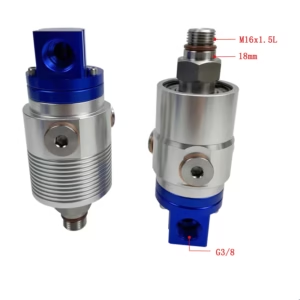High Speed Rotary Unions
Original price was: $50.00.$40.00Current price is: $40.00.
- Product name:Water rotary joints
- Material:Stainless Steel Brass
- Pipe Clamp Size:10/15
- Max.Speed:1000RPM
- Max. Pressure:1.6MPa
- Max.Temperature:100℃
- Applicable Medium:Water, Water heating
Description








 Overview
Overview
Introducing our High-Speed Rotary Union, a cutting-edge solution designed for industries demanding exceptional performance under high-speed and high-pressure conditions. This innovative product is engineered to enhance efficiency and reliability in various applications, from machine tools to automated systems.




 High-speed rotary unions offer a range of significant benefits for industrial applications, enhancing operational efficiency and reliability across various sectors.
High-speed rotary unions offer a range of significant benefits for industrial applications, enhancing operational efficiency and reliability across various sectors.
Continuous Operation
High-speed rotary unions enable uninterrupted rotation, which minimizes system downtime. This is crucial in industries such as aerospace and automotive, where precision and reliability are paramount. By allowing for continuous fluid transfer between stationary and rotating components, these unions ensure that machinery operates smoothly without interruptions.
Versatile Fluid Transfer
The are designed to handle a variety of fluids, including air, water, oil& hydraulic fluids. Their ability to accommodate multiple types of media without contamination is essential for industries that require concurrent processing of different fluids, such as metalworking,chemical processing. The versatility allows for efficient operation in complex systems.
High Pressure and Speed Handling
High-speed rotary unions can withstand high pressures (up to several thousand PSI) and high rotational speeds, making them suitable for demanding applications. This capability is vital in sectors like oil and gas, where equipment operates under extreme conditions.
Enhanced Durability
Constructed from robust materials and featuring advanced sealing technologies, high-speed rotary unions provide a reliable connection that reduces the risk of leaks and contamination. This durability translates to lower maintenance costs and extended service life, which is especially beneficial in harsh industrial environments.
Customization Options
Manufacturers often offer customizable designs to meet specific operational requirements, including size, pressure ratings, and temperature tolerances. This flexibility ensures that high-speed rotary unions can be tailored to fit unique application needs in various industries.
Improved Efficiency
By facilitating optimal fluid flow and reducing friction through advanced seal designs, high-speed rotary unions enhance the overall efficiency of machinery. This improvement can lead to significant energy savings and cost reductions in industrial processes.
Safety Enhancements
In critical applications such as aerospace and automotive systems, high-speed rotary unions contribute to safety by ensuring reliable fluid transfer under high-pressure conditions. Their robust construction helps prevent failures that could lead to hazardous situations.
 What is a high speed rotary unions?
What is a high speed rotary unions?
It is a mechanical device that allows the transfer of fluids (such as coolant or air) between stationary and rotating parts in machinery. It is designed to operate at high rotational speeds, enabling continuous fluid flow without leaks, which is critical in applications like machine tools and automated systems.
What are the applications of high speed rotary union?
Machine Tools: For coolant delivery during machining processes.
Aerospace: In systems requiring high-pressure fluid transfer.
Rubber Mills and Extruders: To manage heat transfer fluids.
Automated Machinery: Ensuring efficient operation in robotics and assembly lines.
How do high speed rotary union work?
These devices consist of a rotating component connected to a stationary supply line. They feature seals that maintain a tight connection while allowing for the rotation of the moving part. This design prevents fluid leakage&contamination while ensuring efficient fluid transfer under varying pressure&temperature conditions.
What are the benefits of using high speed rotary union?
Continuous Operation: Reduces downtime by allowing uninterrupted fluid flow.
Versatility: Compatible with various fluids including oil, coolant, and air.
High Pressure and Speed Handling: Suitable for demanding industrial applications.
Durability: Designed to withstand harsh environments, minimizing maintenance needs.
What materials are used in high speed rotary union?
It is typically made from materials such as aluminum, carbon steel and stainless steel. These materials provide strength, corrosion resistance&durability, ensuring reliable performance in various operational environments.
Can high speed rotary union operate in dry conditions?
Yes, they are designed for both wet and dry run applications. They feature balanced seals that remain closed even when no fluid is present, making them suitable for environments where intermittent fluid flow is necessary.
What factors should be considered when selecting a high speed rotary union?
Rotational Speed: Ensure it meets the requirements of your application.
Pressure Rating: Select a union that can handle the expected pressure levels.
Fluid Compatibility: Make sure it is suitable for the specific fluids used in your system.
Size and Configuration: Choose based on the installation space and flow requirements.
What is the lifespan of a high speed rotary union?
The lifespan can vary based on application conditions such as speed, pressure&fluid type. Generally, well-maintained high speed union can last several million revolutions before requiring replacement or servicing.
What innovations are being made in high speed rotary union technology?
Recent advancements include improved sealing technologies that reduce friction and enhance durability, as well as designs that allow for higher rotational speeds and pressures. Manufacturers focused on developing custom solutions tailored to specific industrial needs, enhancing efficiency across various applications.







